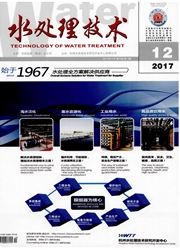

 中文摘要:
中文摘要:
采用自制的氧化铁改性石英砂滤料(简称“改性砂”),对生物改性砂联合处理微污染物氨氮的复合挂膜启动性能以及滤料表面形态进行了试验研究,并与生物普通砂联用效果进行对比。结果表明,生物普通砂和生物改性砂在挂膜初期的生物量分别为15.46、13.79nmol/g(nfP)/m(滤料)),稳定运行期分别为18.75、20.09nmol/g;挂膜初期,生物普通砂与生物改性砂对质量浓度为1~2mg/L氨氮的去除效果分别达到92%和95%;挂膜稳定期,前者对氨氮的去除效果约60%,后者稳定在80%左右;在不同氨氮质量浓度(0.5~4mg/L)下,生物普通砂对氨氮去除率从60%上升至80%,生物改性砂的去除率从70%增至95%;过滤前后2种滤料表面形态均发生变化,生物改性砂表面孔隙更小,结构更加复杂多孔,表面粗糙程度进一步增加,对氨氮去除率高。
 英文摘要:
英文摘要:
A homemade iron oxide cCoated sands filters with biological was used to remove ammonia nitrogen from contaminated source water, the process of compound formation start-up and the surface morphology of the two filters was carried out, and contrasted with the effect of biological-raw sands. The results were showp as follows: The biomass of the biological- raw sand filter, and biological-iron oxide coated sand filter were 15.46 and 13.79 nmot/g in the initial of formation, 18.75 and 20.09 nmol/g in the stable of formation. Removal of ammonia nitrogen with concentration among 1.0-2.0 mg/L using biol0gical-raw sands and biological-iron oxide coated sands were 92% to 95% in the initial of formation, In the stable of formation, removal ammonia nitrogen using biological-raw sands stable about 60%, and removal ammonia nitrogen using biological-iron oxide coated sands stable about 80%. In different concentrations of ammonia nitrogen among 0.5 -4.0 nag/L, removal efficiency of biological-raw sands from 60% rose to 80%, biological- iron oxide coated sands from 70% rose to 95%. The surface morphology of the two filters before and after filtration changed. The surface porosity biologicaliron oxide coated sands were smaller than iron oxide coated sands, and the surface roughness of biological-raw sands were rougher than raw sand.
 同期刊论文项目
同期刊论文项目
 同项目期刊论文
同项目期刊论文
 期刊信息
期刊信息
